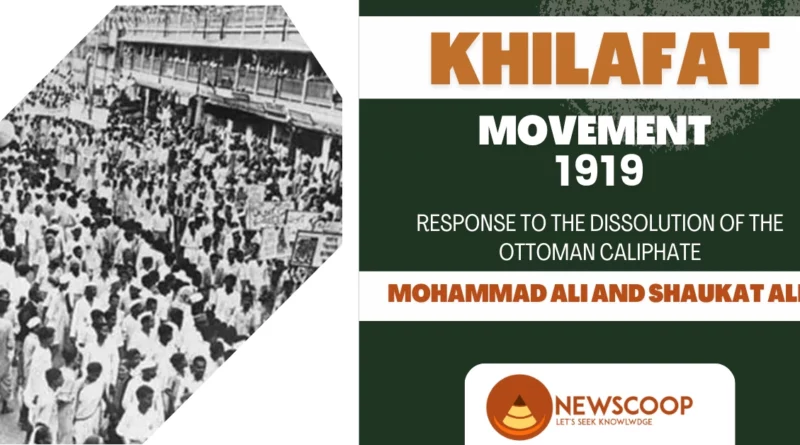Khilafat Movement: History | Objectives, Causes & Decline – UPSC
The Khilafat Movement holds a significant place in India’s freedom struggle against British colonial rule. It emerged as a response to the disintegration of the Ottoman Caliphate after World War I and aimed to safeguard the rights and interests of Muslims in India. The movement not only fostered Hindu-Muslim unity but also played a vital role in shaping the course of India’s fight for independence.
Understanding this Movement is crucial for aspirants preparing for the UPSC exam, as it is an important topic in Indian history. This article aims to provide a comprehensive overview of the Khilafat Movement, its causes, key leaders, its impact, and its eventual decline.
Khilafat Movement in India
The Khilafat Movement emerged as a response to the discontent with British authority and the mistreatment of Turkey during the First World War. It was a movement established in 1919 under the leadership of Mohammad Ali and Shaukat Ali, Abul Kalam Azad, Hasrat Mohani, and other prominent figures. The movement aimed to put pressure on the British government to address the injustices faced by Turkey.
Key Leaders and Contributions
- Maulana Abul Kalam Azad: A prominent scholar and leader, Maulana Azad joined the Khilafat Movement and played a significant role in mobilizing support for the cause. He later became a prominent leader in the Indian National Congress and the first Education Minister of independent India.
- Maulana Mohammad Ali and Shaukat Ali: The Ali Brothers were instrumental in organizing the Khilafat Movement. They traveled extensively across India, delivering speeches, organizing protests, and rallying support for the cause.
- Mahatma Gandhi: Although Mahatma Gandhi was not a Muslim, he extended his support to the Khilafat Movement as a means to forge Hindu-Muslim unity. He saw the movement as an opportunity to mobilize the masses and intensify the fight against British colonial rule.
Overview of History & Background
The Khilafat Movement emerged in response to the dissolution of the Ottoman Caliphate and garnered immense support among Indian Muslims. It aimed to protect the caliphate and preserve the religious identity of Indian Muslims. The formation of the All India Khilafat Committee and its alliance with the Non-Cooperation Movement highlighted the unity between Hindus and Muslims in their struggle against British colonial rule.
Through protests, strikes, and boycotts, the Khilafat Movement exerted significant pressure on the colonial administration. However, the movement faced challenges, including the Chauri Chaura incident and the subsequent withdrawal of the Non-Cooperation Movement. These events contributed to its gradual decline.
Ultimately, the abolition of the caliphate by Mustafa Kemal Ataturk in 1924 marked a turning point for this Movement. Despite its decline, the movement left a lasting legacy, emphasizing the importance of unity and inspiring the ongoing fight for independence and social justice in India.
Objectives of the Khilafat Movement
The Khilafat Movement, spanning from 1919 to 1924, had several key objectives that drove its leaders and participants. Let’s explore the main objectives of the Khilafat Movement:
1. Defense of the Caliphate: The primary objective of the Khilafat Movement was to safeguard the institution of the caliphate, which was seen as a symbol of Islamic unity and leadership. The movement aimed to exert pressure on the British government to protect the caliphate and prevent its dissolution.
2. Protection of Muslim Rights: The movement sought to address the concerns and rights of Muslims in India. It aimed to ensure that Muslims were not marginalized or deprived of their religious, social, and political rights under British colonial rule.
3. Hindu-Muslim Unity: Emphasized the importance of Hindu-Muslim unity in the fight against British imperialism. It aimed to bridge the divide between the two communities and establish a united front in the struggle for independence. The movement believed that solidarity between Hindus and Muslims was crucial for the success of the larger freedom movement.
4. Non-Cooperation with the British: Inspired by Mahatma Gandhi’s Non-Cooperation Movement, the Khilafat Movement adopted the strategy of nonviolent resistance and non-cooperation with British authorities. The objective was to weaken British control by boycotting British-made goods, institutions, and administrative practices.
5. Mobilization of Masses: The movement sought to mobilize the masses, especially Muslims, to actively participate in protests, processions, strikes, and boycotts. The objective was to create widespread awareness, generate public support, and demonstrate the strength of collective action against British rule.
6. International Support for the Caliphate: The Movement aimed to garner international support for the cause of the caliphate. It sought to build alliances and gain sympathy from Muslims and non-Muslims worldwide, advocating for the protection of the caliphate and protesting against the unfair treatment of the Ottoman Empire.
7. Overall Indian Independence: While the Khilafat Movement primarily focused on the concerns of Muslims, it also recognized the broader objective of attaining independence for India as a whole. The movement saw the struggle against British imperialism as a shared goal, working in conjunction with other national movements.
Causes of the Khilafat Movement
Following the main causes that led to the formation of the Khilafat Movement:
- Dissolution of the Ottoman Caliphate: The end of World War I led to the disintegration of the Ottoman Empire and the abolition of the Ottoman Caliphate, the spiritual and political head of the Muslim world. This move deeply affected Indian Muslims, who viewed the caliph as the protector of their religious and political interests.
- The Treaty of Sevres and Khilafat Committee: The Treaty of Sevres (1920) imposed harsh terms on the defeated Ottoman Empire. The Khilafat Committee, led by Maulana Mohammad Ali and his brother Shaukat Ali, was formed in India to protest against the treaty and protect the caliphate.
- Ali Brothers’ Influence: Maulana Mohammad Ali and Shaukat Ali, popularly known as the Ali Brothers, were influential leaders who played a vital role in mobilizing Muslims and creating a united front against British colonialism.
Decline
The decline of the Khilafat Movement can be attributed to several factors that gradually diminished its influence and impact.
Firstly, the decline of the Khilafat Movement was marked by the abolition of the caliphate by Mustafa Kemal Ataturk in 1924. This decision nullified the central cause of the movement, leading to a loss of momentum and support.
Additionally, internal divisions and ideological differences within the Khilafat Movement weakened its unity and effectiveness. Various factions emerged within the movement, with differing strategies, priorities, and visions for the future. These internal conflicts undermined the cohesive strength of the movement and hindered its ability to mobilize the masses effectively.
Moreover, the Khilafat Movement’s association with the Non-Cooperation Movement, led by Mahatma Gandhi, contributed to its decline. When the Non-Cooperation Movement was abruptly called off in 1922 (Chauri Chaura incident), it dealt a severe blow to the Khilafat cause and eroded its popular support.
Furthermore, despite massive mobilization and protests, the Khilafat Movement did not achieve its primary objective of restoring the caliphate. The lack of tangible results and the abolition of the caliphate by Ataturk led to disillusionment and a loss of faith in the movement’s effectiveness.
Lastly, the rise of communal tensions further weakened the Khilafat Movement. Incidents of communal violence began to overshadow the broader goals of the movement, undermining its inclusive and unified approach.
Also Read: Quit India Movement
Conclusion
In conclusion, the Khilafat Movement represented a significant chapter in India’s quest for freedom and justice. It united Muslims under a common cause and showcased the power of collective action. While it faced challenges and eventually declined, the movement’s legacy remains indelible.
Moreover, it highlighted the importance of religious unity and social justice, and its impact resonates in the ongoing struggle for equality and the preservation of cultural identity.
Thank You!

